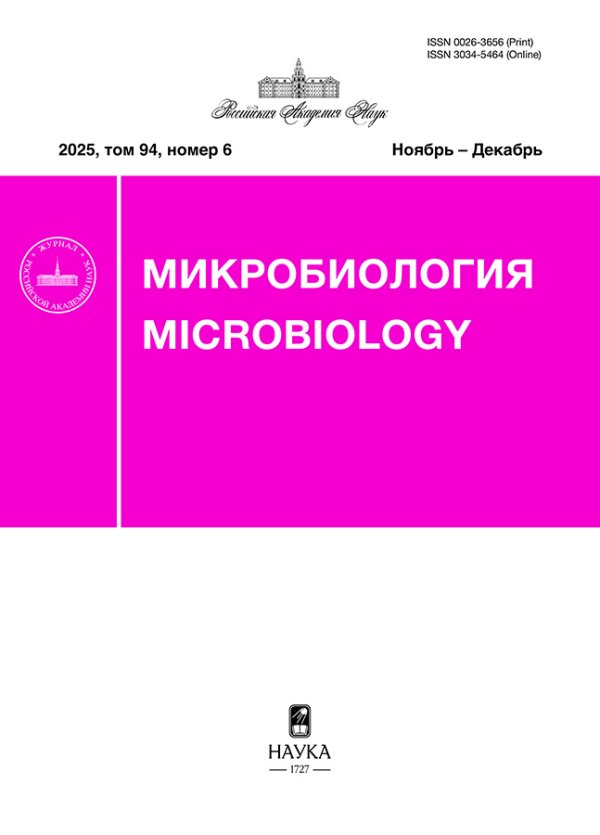Состояние цианобактерии Arthrospira platensis и ассоциированной с ней микрофлоры при длительном хранении в состоянии АНГИДРОБИОЗА
- Авторы: Харчук И.А.1, Рылькова О.А.1, Береговая Н.М.1
-
Учреждения:
- Федеральный исследовательский центр “Институт биологии южных морей им. А.О. Ковалевского РАН”
- Выпуск: Том 92, № 1 (2023)
- Страницы: 31-41
- Раздел: ЭКСПЕРИМЕНТАЛЬНЫЕ СТАТЬИ
- URL: https://journals.rcsi.science/0026-3656/article/view/138164
- DOI: https://doi.org/10.31857/S002636562210024X
- EDN: https://elibrary.ru/NMNLXB
- ID: 138164
Цитировать
Полный текст
Аннотация
Стандартными методами определен биохимический состав Arthrospira (Spirulina) platensis (Nordstedt) Gomont после длительного хранения (4 года, 17 лет) в состоянии ангидробиоза. Показано, что количество белков (55.3–61.2%) и суммарных углеводов (13.0–15.6%) в клетках цианобактерий соответствовало данным, известным из литературы и полученным нами ранее при закладке этих же образцов на хранение. Содержание свободных нуклеотидов (1.8–2.6%), липидов (1.3–11.0%) и, особенно, пигментов было низким (0.5–1.3, 0.03–0.12, 1.4–2.0, 0.03–0.05% соответственно, для хлорофилла а, каротиноидов, С-фикоцианина и аллофикоцианина). Количество нуклеиновых кислот в пробах достигало: 3.1–24.0 и 0.11–0.16% соответственно, для РНК и ДНК. При микроскопическом исследовании A. рlatensis (17 лет хранения) показано наличие 34.2% необратимо поврежденных и 65.8% мертвых клеток. Для определения количественных и морфологических показателей ассоциированной микрофлоры предложено использовать комплексную физико-химическую обработку (метанол, ультразвук, центрифугирование) суспензии реактивированных цианобактерий. В морфологической структуре микробиома выделены 3 основные группы (палочковидные, округлые и извитые формы). В сообществе доминировали палочковидные формы: крупные палочки составляли 60.5%, мелкие палочки – 14.4%. Мицелиальные формы (тонкие нити), кокки и извитые формы встречались реже. В среднем объем бактериальной клетки составлял 0.27 ± 0.04 мкм3. Вклад бактерий составлял от 3.3 до 11.3% (в среднем 8.3 ± 4.4%) от веса сухой биомассы А. рlatensis. Высказано предположение, что на биохимические показатели и жизнеспособность цианобактерий оказывала влияние сопутствующая микрофлора.
Об авторах
И. А. Харчук
Федеральный исследовательский центр “Институт биологии южных морейим. А.О. Ковалевского РАН”
Email: ol.rylkova@yandex.ru
Россия, 299011, Севастополь
О. А. Рылькова
Федеральный исследовательский центр “Институт биологии южных морейим. А.О. Ковалевского РАН”
Автор, ответственный за переписку.
Email: ol.rylkova@yandex.ru
Россия, 299011, Севастополь
Н. М. Береговая
Федеральный исследовательский центр “Институт биологии южных морейим. А.О. Ковалевского РАН”
Email: ol.rylkova@yandex.ru
Россия, 299011, Севастополь
Список литературы
- Агатова А.И. Руководство по современным биохимическим методам исследования водных экосистем, перспективных для промысла и марикультуры. М.: Изд-во ВНИРО, 2004. 123 с.
- Бекер М.Е., Дамберг Б.Э., Рапопорт А.И. Анабиоз микроорганизмов. Рига: Зинатне, 1981. 252 с.
- Гевориз Р.Г., Нехорошев М.В. Количественное определение массовой доли С-фикоцианина и аллофикоцианина в сухой биомассе Spirulina (Arthrospira) platensis North. Geitl. Холодная экстракция, Севастополь 2017 // Электронный ресурс https://repository.marine-research.org/handle/299011/46 (дата обращения 19.10.2021).
- Копытов Ю.П., Дивавин И.А., Цымбал И.М. Схема комплексного биохимического анализа гидробионтов // “Рациональное использование ресурсов моря – важный вклад в реализацию продовольственной программы”: материалы конф. ИнБЮМ АН УССР. Севастополь, 1985. Т. 4.2. С. 227–231. Деп. в ВИНИТИ 16.04.85, № 2556-85.
- Мейсель М.Н., Медведева Г.А., Алексеева В.М. О выявлении живых, поврежденных и мертвых микроорганизмов // Микробиология. 1961. Т. 30. С. 855–862.
- Рауэн Т.В., Ханайченко А.Н., Муханов В.С. Влияние микроводорослей и их фильтратов на численность бактерий в среде выращивания камбалы калкана // Морской экологический журн. 2011. Т. 10. № 3. С. 48‒56.
- Рылькова О.А., Гулин С.Б., Пименов Н.В. Определение общей численности микроорганизмов в донных осадках Черного моря методом проточной цитометрии // Микробиология. 2019. Т. 88. С. 685‒694.
- Rylkova O.A., Gulin S.B., Pimenov N.V. Determination of the total microbial abundance in Black Sea bottom sediments using flow cytometry // Microbiology (Moscow). 2019. V. 88. P. 700‒708.
- Сиренко Л.А., Сакевич А.И., Осипович Л.Ф. Методы физиолого-биохимического исследования водорослей в гидробиологической практике. Киев: Наукова думка, 1975. 247 с.
- Слизень В.В., Кирильчик Е.Ю., Шабан Ж.Г., Черношей Д.А., Канашкова Т.А. Лабораторный практикум по общей микробиологии. 5-е изд. Минск: БГМУ, 2020. 80 с.
- Спирин А.С. Спектрофотометрическое определение суммарного количества нуклеиновых кислот // Биохимия. 1958. Т. 23. С. 656–662.
- Стадничук И.Н. Фикобилипротеины. Итоги науки и техники. Сер. Биол. химия. М. ВИНИТИ, 1990. Т. 40. 196 с.
- Тархова Э.П. Микроорганизмы, сопутствующие Spirulina platensis в накопительной питательной культуре // Экология моря. 2005. Вып. 70. С. 49‒52.
- Харчук И.А. Влияние длительности хранения на жизнеспособность клеток Spirulina platensis (Nordst.) в состоянии ангидробиоза // Экология моря. 2007. Вып. 74. С. 80–83.
- Харчук И.А. Динамика компонентов биохимического состава Spirulina platensis Nords. при ангидробиозе // Экология моря. 2008. Вып. 76. С. 67‒71.
- Харчук И.А. Способ длительного хранения микроводорослей. RU 2541452 C1 от 10.02.2015.
- Харчук И.А. Динамика жизнеспособности и компонентов биохимического состава Arthrospira (Spirulina) platensis (Nords) Gomont в зависимости от температуры дегидратации при переводе в состояние ангидробиоза // Вопросы современной альгологии. 2018. № 1(16). http://algology.ru/1258
- Шлегель Г. Общая микробиология. М.: Мир, 1987. 566 с.
- Bratbak G., Kemp P.F., Sherr B.F., Sherr E.B., Cole J.J. Microscope methods for measuring bacterial biovolume: Epifluorescence microscopy, scanning electron microscopy, and transmission electron microscopy // Handbook of Methods in Aquatic Microbial Ecology / Eds. Cole J.J. Boca Raton: CRC Press, 1993. Ch. 36. P. 309–317. https://doi.org/10.1201/9780203752746
- Ciferri O. Spirulina, the edible microorganism // Microbiol. Rev. 1983. V. 47. P. 551‒578.
- Falquet J., Hurni J.P. Spiruline Aspects Nutritionnels. Antenna Technologies, 2006. 41 p.
- Faucher O., Coupal B., Leduy A. Utilization of scawater – urea as a culture medium for Spirulina maxima // Can. J. Microbiol. 1979. V. 25. P. 752.
- Kallmeyer J., Smith D.C., Spivac A.J., D’Hondt S. New cell extraction procedure applied to deep subsurface sediments // Limnol. Oceanogr. Methods. 2008. V. 6. P. 236–245.
- Kannaujiya V.K., Sinha R.P. Thermokinetic stability of phycocyanin and phycoerythrin in food-grade preservatives // J. Appl. Phycol. 2016. V. 28. P. 1063–1070. https://doi.org/10.1007/s10811-015-0638-x
- Liu Q., Huang Y., Zhang R., Cai T., Cai Y. Medical application of Spirulina platensis derived C-phycocyanin // Evid. Based Complement. Alternat. Med. 2016. V. 2016. 14 p. Art. 7803846. https://doi.org/10.1155/2016/7803846
- Lowry O.H., Rosebrough N.J., Farr A.L., Randall R.J.P. Protein measurement with folin phenol reagent // J. Biol. Chem. 1951. V. 193. P. 265–275.
- Lunau M., Lemke A., Walther K., Martens-Habbena W., Simon M. An improved method for counting bacteria from sediments and turbid environments by epifluorescence microscopy // Environ. Microbiol. 2005. V. 7. P. 961–968.
- Mogale M. Identification and quantification of bacteria associated with cultivated Spirulina and impact of physiological factors. University of Cape Town, 2016. http://hdl.handle.net/11427/22921
- Nalage D., Khedkar G., Kalyankar A., Sarkate A., Ghodke S., Bedre V.B., Khedkar C.D. Single cell proteins // The Encyclopedia of Food and Health / Eds. Caballero B., Finglas P., Toldra F. London, UK: Oxford, Academic Press, 2016. V. 4. P. 790‒794.
- Rowan K.S. Photosynthetic Pigments of Algae. Cambridge: Cambridge Univ. Press, 1989. 334 p.
- Vardaka E., Kormas K.A., Katsiapi M., Genitsaris S., Moustaka-Gouni M. Molecular diversity of bacteria in commercially available “Spirulina” food supplements // PeerJ. 2016. V. 4. P. 1610.
- Velji M.I., Albright L.J. Microscopic enumeration of attached marine bacteria of seawater, marine sediment, fecal matter and kelp blade samples following pyrophosphate and ultrasound treatments // Can. J. Microbiol. 1986. V. 32. P. 121–126.
- Vonshak A. (ed.) Spirulina platensis (Arthrospira). Physiology, Cell-Biology and Biotechnology. CRC Press, 1997. 233 p.
Дополнительные файлы















